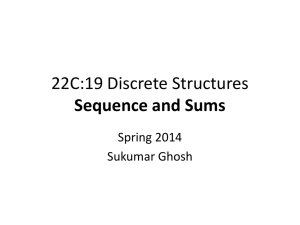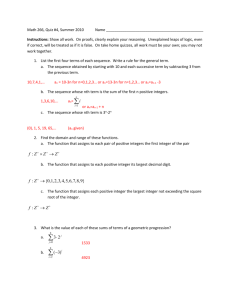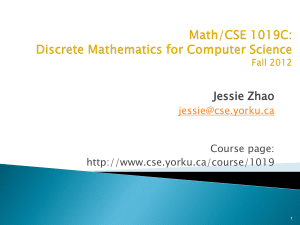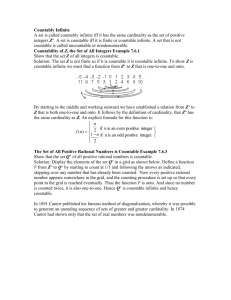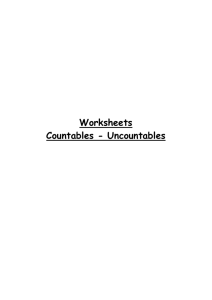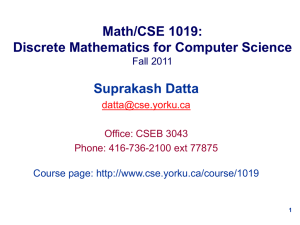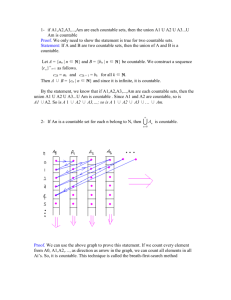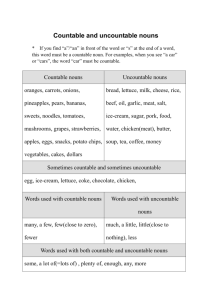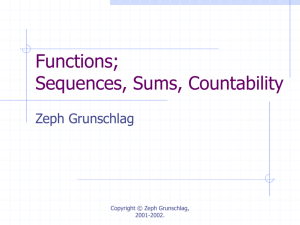Countable and Uncountable Sets
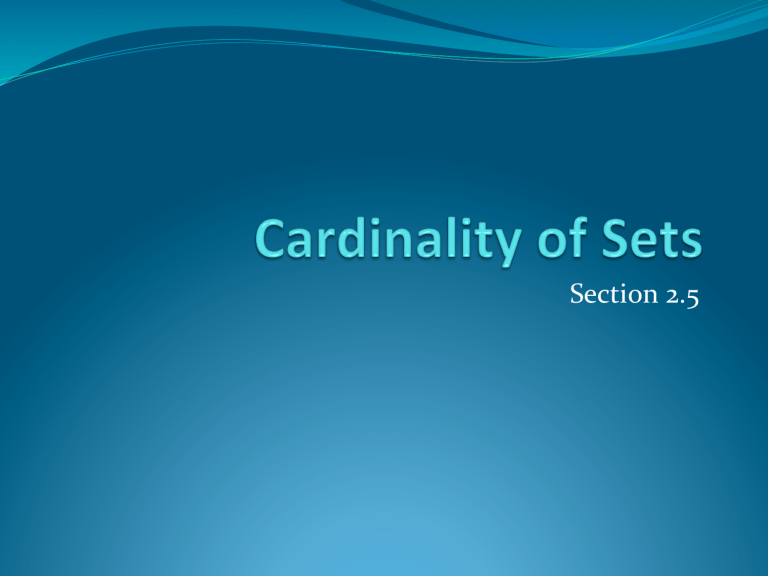
Section 2.5
Cardinality
(another) Definition : The cardinality of a set A is equal to the cardinality of a set B , denoted
|A| = | B |,
if and only if there is a bijection from A to B .
If there is an injection from A to B , the cardinality of
A is less than or the same as the cardinality of B and we write | A | ≤ | B |.
Cardinality
Definition : A set that is either finite or has the same cardinality as the set of positive integers ( Z + ) is called countable . A set that is not countable is uncountable .
The set of all finite strings over the alphabet of lowercase letters is countable.
The set of real numbers R is an uncountable set.
Showing that a Set is Countable
An infinite set is countable if and only if it is possible to list the elements of the set in a sequence (indexed by the positive integers).
f
The reason for this is that a bijection f from the set of positive integers to a set S can be expressed in terms of a sequence
( 2 ) , …, a n
= f ( n ) ,… a
1
,a
2
,…, a n
,… where a
1
= f ( 1 ) , a
2
=
Showing that a Set is Countable
Example 1 : Show that the set of positive even integers is countable set.
Proof : Let E be the set of even integers and f ( x ) function from N to E.
1 2 3 4 5 6 …..0
= 2 x be a
2 4 6 8 10 12 ……
Then f is a bijection from N to E since f is both one‐to‐one and onto. To show that it is injective, suppose that f ( n )
= f ( m ). Then 2 n = 2 m , and so n = m . To see that it is surjective, suppose that t is some even positive integer.
Then t = 2 k for some positive integer k and f ( k ) = t .
Showing that a Set is Countable
Example 2 : Show that the set of all integers Z is countable.
Proof : We can list the integers in a sequence:
0, 1, − 1, 2, − 2, 3, − 3 ,………..0
Let f be a function from N to Z defined as
When n is even: f ( n ) = n/ 2
When n is odd: f (n) = − ( n − 1 )/ 2 that generates this list. We now show that this function is a bijection. First we show that it is injective by case analysis on the parity of N .
Showing that a Set is Countable
Let m and n be two even natural numbers, then f(m) = m/2 and f(n) = n/2, it follows that f(m)=f(n) implies m=n.
Let m and n be two odd natural numbers, then f(m) = ‐(m‐1)/2 and f(n) = ‐(n‐1)/2, it follows that f(m)=f(n) implies m=n.
Therefore, f is injective. We now show that f is surjective by case analysis on the sign of some integer t in Z .
Let t be positive, then t will appear in an even position in the sequence, thus f(2k)=2k/2=t with t=k. This implies that for every positive value t in Z there is a natural number 2k.
Let t be negative, then t will appear in an odd position in the sequence, thus f(2k‐1)=‐(2k‐1‐1)/2=t with t=‐k. This implies that for every negative value t in Z there is a natural number 2k‐1.
Therefore, f is surjective. (QED)
Strings
Example 4 : Show that the set of finite strings S over the lowercase letters is countably infinite.
Proof : Show that the strings can be listed in a sequence.
First list
1.
All the strings of length 0 in alphabetical order.
2.
3.
4.
Then all the strings of length 1 in lexicographic (as in a dictionary) order.
Then all the strings of length 2 in lexicographic order.
And so on.
This implies a bijection from N to S and hence it is a countably infinite set.
The set of all Java programs is countable.
Example 5 : Show that the set of all Java programs is countable.
Solution : Let S be the set of strings constructed from the characters which can appear in a Java program. Use the ordering from the previous example. Take each string in turn:
Feed the string into a Java compiler. (A Java compiler will determine if the input program is a syntactically correct Java program.)
If the compiler says YES, this is a syntactically correct Java program, we add the program to the list.
We move on to the next string.
In this way we construct an implied bijection from N to the set of Java programs. Hence, the set of Java programs is countable.
The Real Numbers are
Uncountable
Example : Show that the real numbers are not countable.
Proof: It is sufficient to show that the real numbers between 0 and 1 are not countable. Proof by contradiction. Assume that the real numbers
between 0 and 1 are countable, then we can list them, r
1
= 0.
d
11 d
12 d
13
… d
1 n
…
!
r
2 r
3 r n
= 0.
d
21 d
= 0.
d
31 d
= 0.
d n 1 d
22
32 n 2 d
23 d
33 d n 3
… d
2 n
… d
3 n
… d nn
…
…
…
!
However, given this list we can now construct a new real number r between 0 and 1 that does not appear on this list, q r q
= 0.
d q 1 d q 2 d q 3
… d qn
… with d q 1
!
d
11
, d q 2
!
d
22
, d q 3
!
d
33
, … , d qn
!
d nn
, …
The Real Numbers are
Uncountable
With this construction r q
differs from any real number on the list in at least one position. This is a contradiction. Therefore, the real numbers between 0 and 1 are uncountable. (QED)
